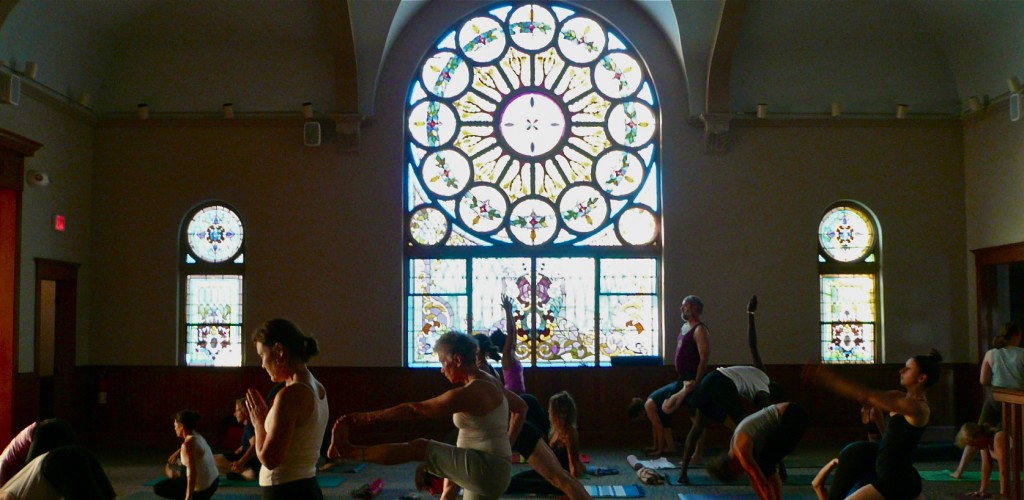It’s Not About the Content: A Retreat on Listening
by Angela
WHEN.Â
July 21, 2013. 10-4. (Mysore practice from 8-9:30.)
WHERE.
Stone Arch, a decommissioned church in downtown Saline. (Pictured above.) Carpool available.
WHO.
Open now to all regular Mysore practitioners at AY:A2. Retreat opens June 21 to anyone who has taken class with me and has a daily practice in the yoga tradition: drop a line now if you’re interested.
WHAT.
(1) Regular morning Mysore practice (for AY:A2 members, and others by permission), (2) Break for drinks (Ashtangis take over the Drowsy Parrot), (3) Technique class on integrating asana, pranayama and pratyhara, (4) Breathwork and guided pratyhara on working with the in-drawn senses, including techniques for enhancing the likelihood of spontaneously dropping into stillness, (5) Lunch by Kasia, who catered our summer 2012 retreat, (6) Party favors as usual.
TO PREPARE.
(1) Register by email, and pay to confirm.
(2) Watch this closely. Read this closely. Unlike our previous retreats, there is no book. Instead, read the book of your own life, as Krishnamurti urges in the article above. But read your life, listen to your inner world (body and mind together) not for meaning or for content: listen instead like John Cage says he listens.
(3) Play with the dharana technique BKS Iyengar describes in Light on Yoga: when you are looking intently at an object, look with your ears. Sound impossible? Just play and notice the effects. We will work with this in detail on the retreat, and that experience will be much more interesting if you do some practice beforehand.
PRICE.
Sliding scale. (1) Full-time academic students or those in financial need: 50 (this is below cost – please do come). (2) Bourgeois Professionals (you might be bourgeois if… you think you might be bourgeois): 100. (3) Support a student: 125.
THEME.
Once an artist invited me to write an article about subjective experiences of energy in the body. I interviewed a dozen ashtangis, spent hours interpreting and embellishing their stories, then edited everything into a florid, evocative cantata. And then: the artist translated the whole thing to braille. Everything down to the byline: just some bumps on a smooth plane.
Can the meaning-making function be perceived as nothing but ones and zeroes, or like a series of raised dots? Yes! And beautifully so. John Cage describes it thus:
When I hear what we call music, it seems to me that someone is talking. And talking to me about his feelings, and about his ideas, of relationships…. But when I hear traffic, I don’t have the feeling that anyone is talking. I have the feeling that sound is acting. And I LOVE the activity of sound. It gets louder and quieter, higher and lower, and it gets longer and shorter… I’m completely satisfied with that. People expect listening to be more than listening, and so sometimes they speak of the meaning of sound. When I talk about music, it finally comes to people’s minds that I’m talking about sound that doesn’t mean anything…. I love sounds just as they are and I have no need for them to be anything more than what they are. And the sound experience which I prefer to all others (smile), is silence.
This retreat, and the sensitizing exercises of the next six weeks, are about raw listening. Close listening. Naked listening. Minimalist listening. A sort of receptivity that not only (1) sets the stage for consciousness to fall into a restful state, but is also (2) completely OK with the fluctuations of the mind just as they are.
Classical yoga offers thousands of techniques to change our inner experience. This is good. But having a body means that fluctuations will arise. The same is true for having a mind. If you breathe, there will be vrittis.
So, in addition to having the tools to quiet or the mind, it is also good – and surprisingly enjoyable at times- to be able to step back and let experience be whatever it wants to be. No fix-its. No analysis. Just hanging out, consciously, with the mind as it is.
Minimalist listening of this sort is a big part of yoga. It is a kind of self-acceptance. And as the patterning of the mindbody’s blips and bump become clear, a door in consciousness opens to calm, curious self-appreciation. It brings on a John Cage sort of laughter… the kind doesn’t mean anything at all.
Space is limited. But not particularly exclusive. Drop a line to inquire.
REFERENCES.
Brenda Ueland’s essay “The Art of Listening†in Strength to Your Sword Arm: Collected Writings; Light on Yoga by BKS Iyengar; The Listening Book, William Allaudin Mathieu’s  collection of techniques for musicians on savoring sound and sharpening your ear; and Shinzen Young’s magnum opus, Five Ways to Know Yourself as a Spiritual Being, esp. pp. 22, 36, 53 and 93. Thanks to Christopher Conn of Edinburgh for inspiring the theme.

http://www.readability.com
This will make the Krishnamurti article much easier to read.
Just reading Brenda Ueland’s If You Want to Write. Love. Can’t wait for this, AJ. Thank you.
Fran! I thought of last week when reading Brenda Ueland, and hoped you would note this reference.
I first learned about Ueland last year from (Zingerman’s CEO) Ari Weinzweig, who is a key inspiration to me on the topic of building environmentally and politically conscious business in Ann Arbor. (His book The Lapsed Anarchist’s Guide to Being a Better Leader is kind of amazing, BTW.)